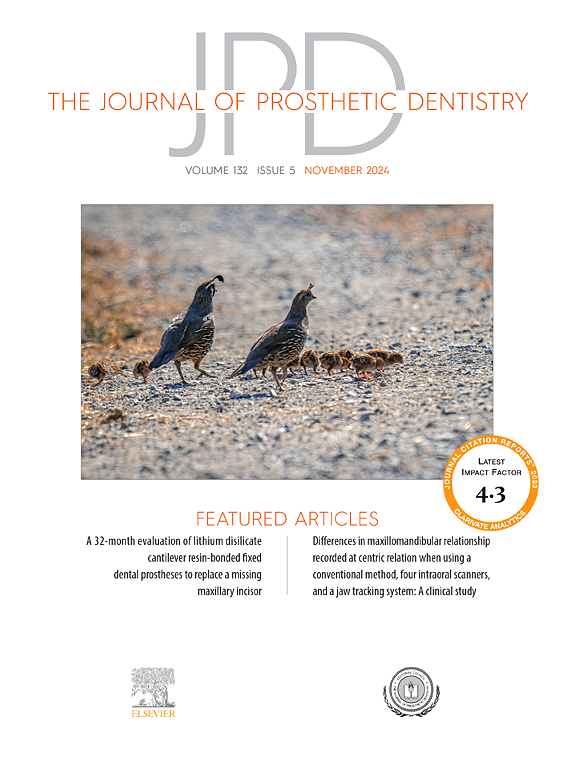Relationship between sleep bruxism and masticatory performance in healthy adults: A cross-sectional study
IF 4.8
2区 医学
Q1 DENTISTRY, ORAL SURGERY & MEDICINE
引用次数: 0
Abstract
Statement of problem
Bruxism may have positive clinical consequences, but whether it contributes to masticatory function remains unclear.
Purpose
The purpose of this clinical study was to clarify the relationship between sleep bruxism and masticatory performance in young adults with healthy dentitions and to determine the roles of occlusal force, dental occlusion, temporomandibular disorders (TMDs), and jaw symptoms.
Material and methods
Ninety-seven dental students with healthy dentitions participated in this cross-sectional study (median age, 21.9 years; 84 women). Sleep bruxism was assessed at the dental level as the relative peeled area of a BruxChecker worn for 3 nights. Occlusal contact area and maximum occlusal force were measured using silicone transillumination and the Innobyte system. Frequencies of bruxism-related jaw symptoms and TMD were determined using the BruxScreen and diagnostic criteria for TMD protocols. Masticatory performance was assessed by masticating bagged silicone for 20 cycles and calculating the masticatory performance index as the percentage of silicone in weight that passed a 3.15-mm sieve. Bivariate and multiple linear regression analyses were performed, followed by moderated mediation modeling that considered the relative peeled area as a predictor, masticatory performance index as an outcome, and sex as a covariate (α=.05).
Results
Relative peeled area showed a bivariate positive correlation with the masticatory performance index (P<.05), but this was not significant in the stepwise multiple regression model (P>.05). Moderated mediation analysis revealed the relative peeled area exerted a positive indirect effect on masticatory performance via the occlusal force and occlusal contact area, which functioned as serial mediators. This indirect effect was not significant in participants with TMD pain and frequent jaw symptoms (P>.05).
Conclusions
Sleep bruxism may enhance masticatory performance in healthy dentate adults without TMD pain or bruxism-related jaw symptoms. This effect is primarily mediated by an increase in occlusal force and an enlargement of the occlusal contact area.
健康成人睡眠磨牙与咀嚼功能的关系:一项横断面研究。
问题陈述:磨牙症可能有积极的临床结果,但是否有助于咀嚼功能尚不清楚。目的:本临床研究的目的是阐明牙齿健康的年轻成人睡眠磨牙症与咀嚼行为之间的关系,并确定咬合力、牙合、颞下颌障碍(TMDs)和颌骨症状在磨牙症中的作用。材料和方法:97名牙齿健康的牙科学生参加了本横断面研究(中位年龄21.9岁;84名女性)。睡眠磨牙症在牙齿水平评估为佩戴3晚的BruxChecker的相对剥落面积。采用硅胶透照和Innobyte系统测量牙合接触面积和最大咬合力。使用BruxScreen和TMD方案诊断标准确定磨牙相关颌骨症状和TMD的频率。咀嚼性能通过将袋装硅胶咀嚼20次,并以硅胶通过3.15 mm筛子的重量百分比计算咀嚼性能指标来评估。进行了双变量和多元线性回归分析,然后进行了适度的中介建模,将相对剥皮面积作为预测因子,咀嚼性能指数作为结果,性别作为协变量(α= 0.05)。结果:相对去皮面积与咀嚼性能指数呈双变量正相关(p < 0.05)。有调节的中介分析表明,相对去皮面积通过咬合力和咬合接触面积对咀嚼性能有正向的间接影响,这两个因素是连续的中介。这种间接影响在TMD疼痛和频繁颌骨症状的参与者中不显着(P < 0.05)。结论:睡眠磨牙可提高健康有齿成人的咀嚼功能,但无颞下颌关节疼痛或磨牙相关的颌骨症状。这种效应主要是由咬合力的增加和咬合接触面积的扩大所介导的。
本文章由计算机程序翻译,如有差异,请以英文原文为准。
求助全文
约1分钟内获得全文
求助全文
来源期刊

Journal of Prosthetic Dentistry
医学-牙科与口腔外科
CiteScore
7.00
自引率
13.00%
发文量
599
审稿时长
69 days
期刊介绍:
The Journal of Prosthetic Dentistry is the leading professional journal devoted exclusively to prosthetic and restorative dentistry. The Journal is the official publication for 24 leading U.S. international prosthodontic organizations. The monthly publication features timely, original peer-reviewed articles on the newest techniques, dental materials, and research findings. The Journal serves prosthodontists and dentists in advanced practice, and features color photos that illustrate many step-by-step procedures. The Journal of Prosthetic Dentistry is included in Index Medicus and CINAHL.
 求助内容:
求助内容: 应助结果提醒方式:
应助结果提醒方式:


